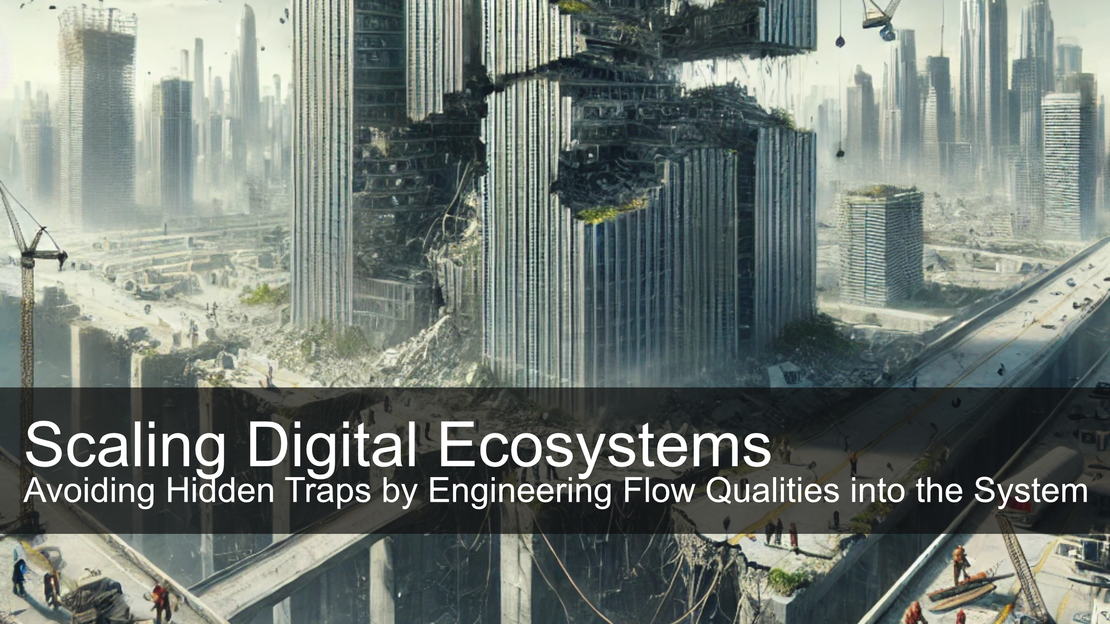
Scaling Digital Ecosystems – Avoiding Hidden Traps by Engineering Flow Qualities into the System
Table of Contents
Rapid growth in a digital ecosystem is difficult and risky - often because future failure is unintentionally built into the system from day one. While avoidable, it remains unaddressed in future iterations since this debt and its risks are not actively managed (explicit vs. implicit decisions about managing debt).
The Hidden Risks of Rapid Growth in Digital Ecosystems
A common response is to duct-tape around bottlenecks, treating symptoms instead of root causes. This approach carries the risk of falling into a cycle of endless patchwork fixes - a vicious circle.
Technical debt compounds over time and can spill into organizational debt. The Inverse Conway Maneuver can help, but its success depends on key factors: architectural maturity, systems thinking, and situational awareness, among others. In short, it requires thinking beyond the obvious - outside the box.
If architectural and organizational changes are not planned together and ahead of time, critical tipping points may be missed. This can lead to scaling dysfunctions that exacerbate existing gaps in knowledge and explicit debt.
The Key to Sustainable Growth: Empowerment and Decentralization
Growth requires decentralization. However, decentralization during rapid scaling can also magnify dysfunctions caused by knowledge gaps and a lack of standardization - especially in areas like architecture, where grassroots initiatives may lack alignment as a team discipline.
Ways to Avoid Getting Trapped by Implicit Debt During a Growth Phase
- Align architecture and organization design – Apply the Inverse Conway Maneuver to ensure that teams and architecture evolve in harmony.
- Set global quality goals – Go beyond technical metrics (availability, security, scalability) and include social aspects like flow efficiency, time to market, internal developer experience, and maintainability.
- Empower architectural decision-making – Architecture is a shared responsibility. Scrum Masters, Product Owners, Line Managers, Product Management, UX Designers, and Developers should all actively consider both functional and non-functional aspects of a system. It’s not just about technologies (yes, even Kubernetes) – it’s about making trade-offs to achieve measurable quality goals while managing risks and debt without jeopardizing growth. Engineering teams should own their architectural decisions, particularly regarding sociotechnical qualities.
- Establish guardrails – Define cross-cutting quality goals and provide clear technology guidelines to reduce upskilling efforts and improve knowledge sharing.
- Foster situational awareness – Encourage teams to think beyond their immediate scope and understand the broader ecosystem they operate in.
My Favorite Collaborative Tools for Decision-Making
Common mainstream techniques that have been around for a while (years indicate when they gained traction in digital ecosystems, platforms, DevOps, etc.):
Domain-Driven Design (~2003-2010) and Event Storming (~2013-2015) - Helps define proper system boundaries, enabling small, effective teams to iterate independently. A shared understanding of business context, terminology, constraints, KPIs, and SLAs makes a significant difference. When engineering teams internalize these aspects while designing software and writing code, the entire system benefits. Additionally, these techniques help manage cognitive load by clearly defining boundaries.
Wardley Mapping (~2016) - Provides a powerful way to visualize digital ecosystems, often offering a more intuitive approach than Context Mapping. If teams struggle to model their system’s context within a few minutes of onboarding, this collaborative exercise can help them develop a broader perspective (situational awareness).
ARC42 Architecture Documentation Template (~2005) - An open-source framework that structures multiple levels of architecture, balancing local optimization for required qualities and skills within bounded contexts. It empowers architecture agents to guide decision-making efficiently and effectively.
Team Topologies / Team Interaction Modeling (~2019) - Supports the creation of team structures and interactions that enable the practical implementation of Domain-Driven Design. It also helps simulate team interactions through techniques like Value Stream Mapping.
Dynamic Reteaming Patterns and Team Ecocycle (~2017-2020) - Aligns organizational evolution with architectural changes to support long-term adaptability. Many architectural changes trigger necessary team structure changes. Agile organizations proactively manage these transitions before reaching tipping points.
Value Stream Mapping (~2000) and Flow Engineering (~2024) - Focuses on improving interactions between people, teams, and systems, ensuring individuals can achieve their goals without constant disruptions due to poor system design. This often reveals the need to re-architect technical components of the system as well.
Final Thoughts
Sustainable growth in digital ecosystems depends on aligning architecture and organization, setting quality goals beyond just technical aspects, and fostering situational awareness. The real challenge is not just managing complexity but ensuring that teams have the autonomy and knowledge to make informed decisions.
At the end of the day, it’s up to us to create an environment where people feel safe to be transparent about their sociotechnical skill gaps. Unconscious incompetence is risky – but conscious incompetence is the first step toward continuous improvement. Where do you stand?